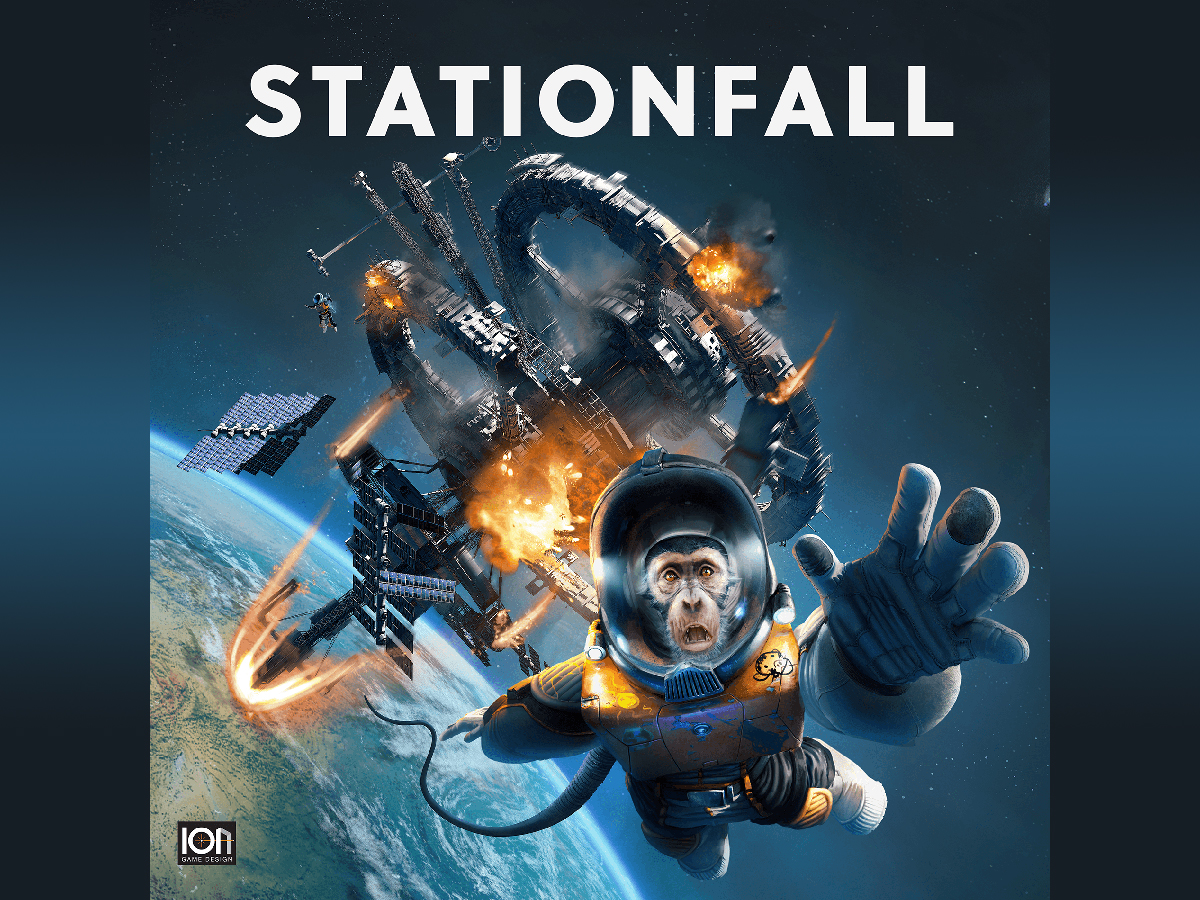
The space station will be burning up in Earth’s atmosphere shortly—you’ve got 15 minutes to get your affairs in order before Stationfall.
What Is Stationfall?
Stationfall is a game for 1 to 9 players, ages 14 and up, and takes about 90–120 minutes to play. It’s currently seeking funding on Kickstarter, with a pledge level of $64 for a copy of the game, or $99 for a copy of the game with miniatures (plus shipping); there’s also an option to get a neoprene playmat. There’s a lot going on this game and learning can be a pretty involved process, so I wouldn’t recommend going much lower than 14 unless your kids are very patient with rules.
Stationfall was designed by Matt Eklund and published by Ion Game Design, with illustrations by Anne Isaksson and Madeleine Fjäll, and graphic design by Josefin Strand and Robin Spathon Ek.
New to Kickstarter? Check out our crowdfunding primer.
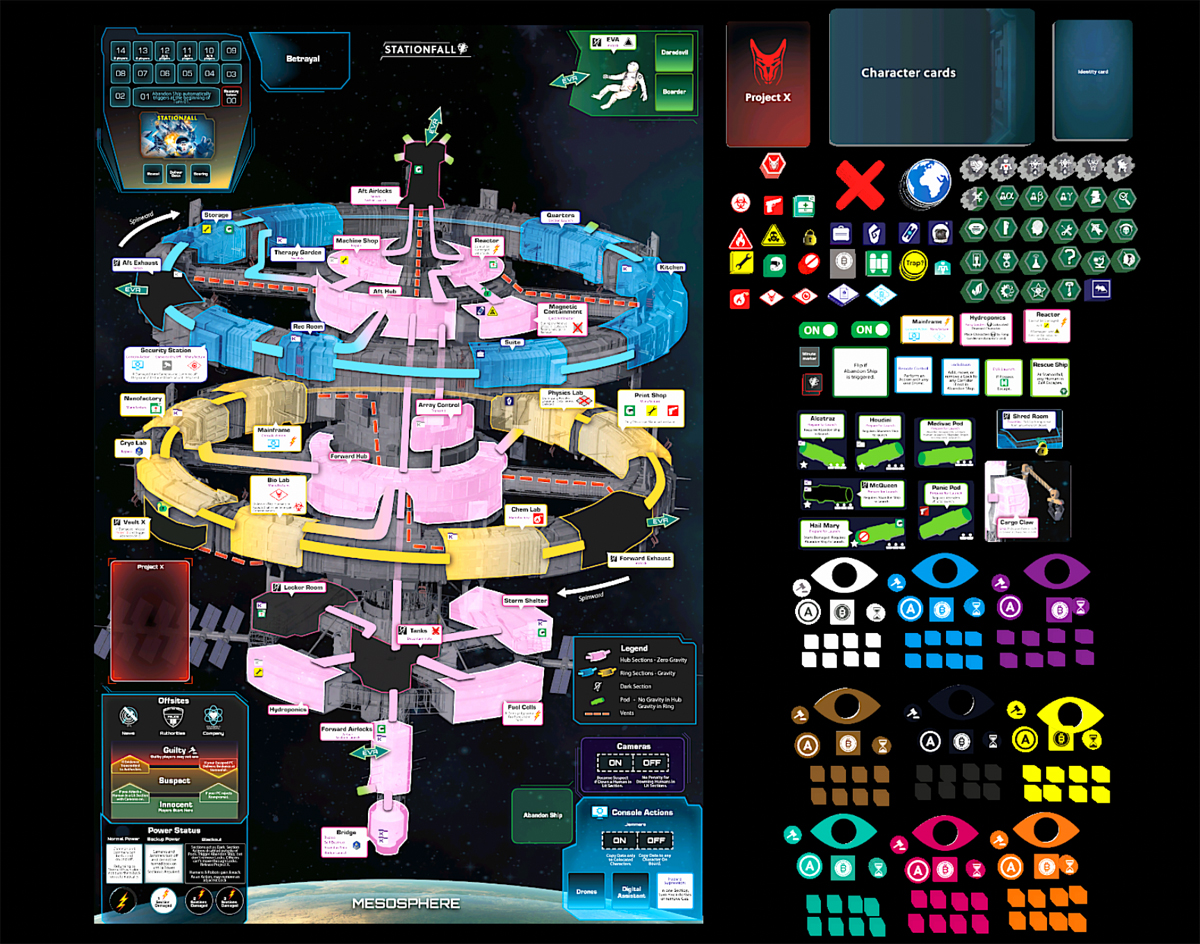
Stationfall Components
Note: I played Stationfall primarily on Tabletop Simulator (along with one play on a physical prototype I was loaned briefly), so most of my images will come from the Tabletop Simulator module. Graphics are subject to change—not all of the artwork was complete yet. I didn’t have exact numbers for some of the tokens, but there are a lot.
Here’s what comes in the box:
- Game board
- 8 Project X cards
- 27 Character cards
- 27 Identity cards
- Cardboard tokens (including tools, guns, helmets, contamination, nanomeds, evidence, and much more)
- 26 Kompromat tokens
- 29 Wooden Character pawns
- Wooden Monster pawn
- Escape Pod tiles
- Various Character-Specific tokens and tiles
- 9 sets of player components:
- Guilt marker
- Reveal marker
- Activation disc
- Bribe marker
- Time discs
- 8 Influence cubes
Also, the game will come with a Playbook, a Rulebook, and a Character Information Book: the Rulebook is intended to be more concise, organized like a big outline with an index, so that you can look things up easily during play. The Character Information book will include back stories for each of the characters, as well as some more in-depth explanations of character-specific rules.
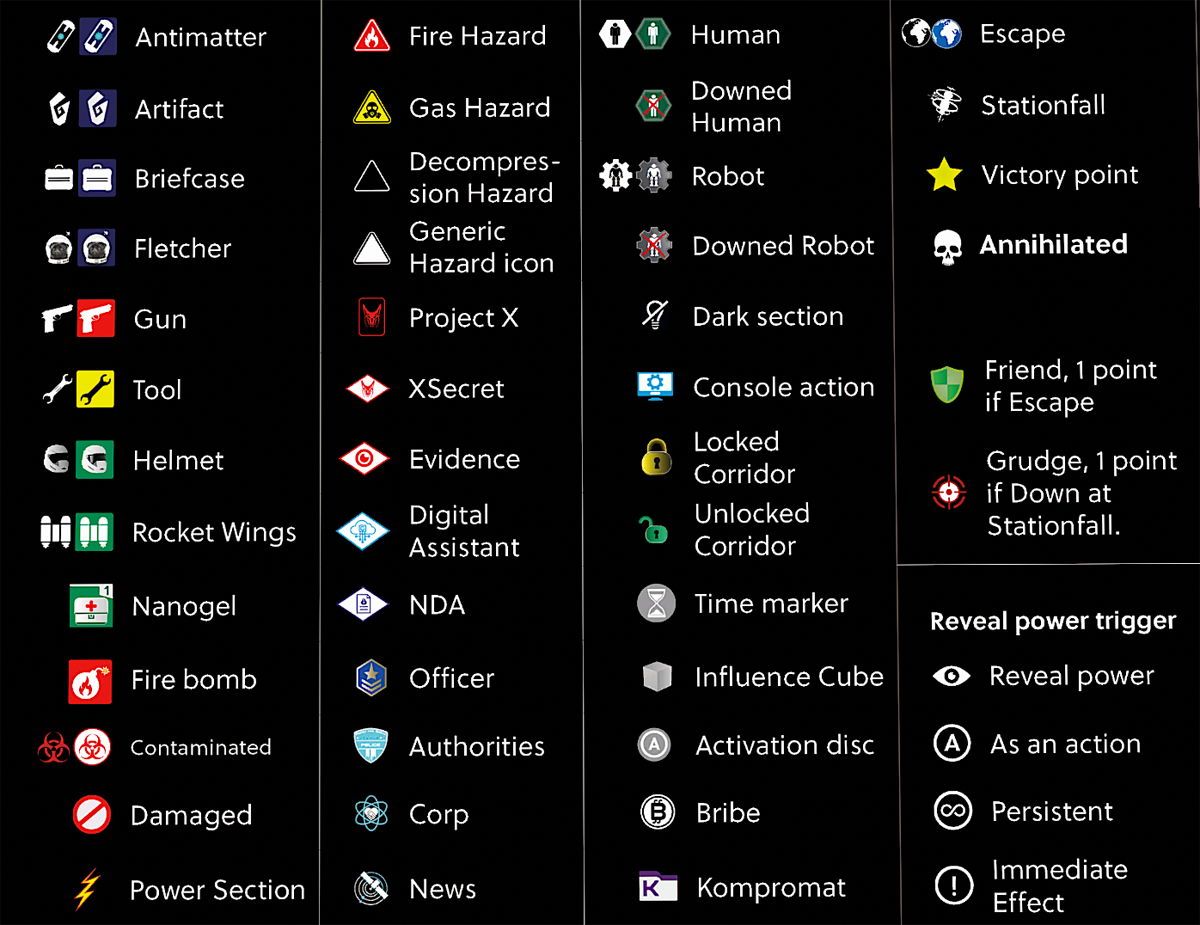
The first thing you’ll notice about Stationfall is that there’s a lot of information everywhere. The board is huge and has all sorts of labels and icons everywhere. The large character cards have a character portrait along the right edge, but then everything else is information: character powers, scoring, and reveal abilities. Icons are often used when explaining effects or abilities, and you can see from the chart above that there are a bunch, some more intuitive than others. It can be a little overwhelming at first glance (or even at a second glance, really) but between the icon reference and the rulebook index, you can usually figure out what things mean fairly easily.
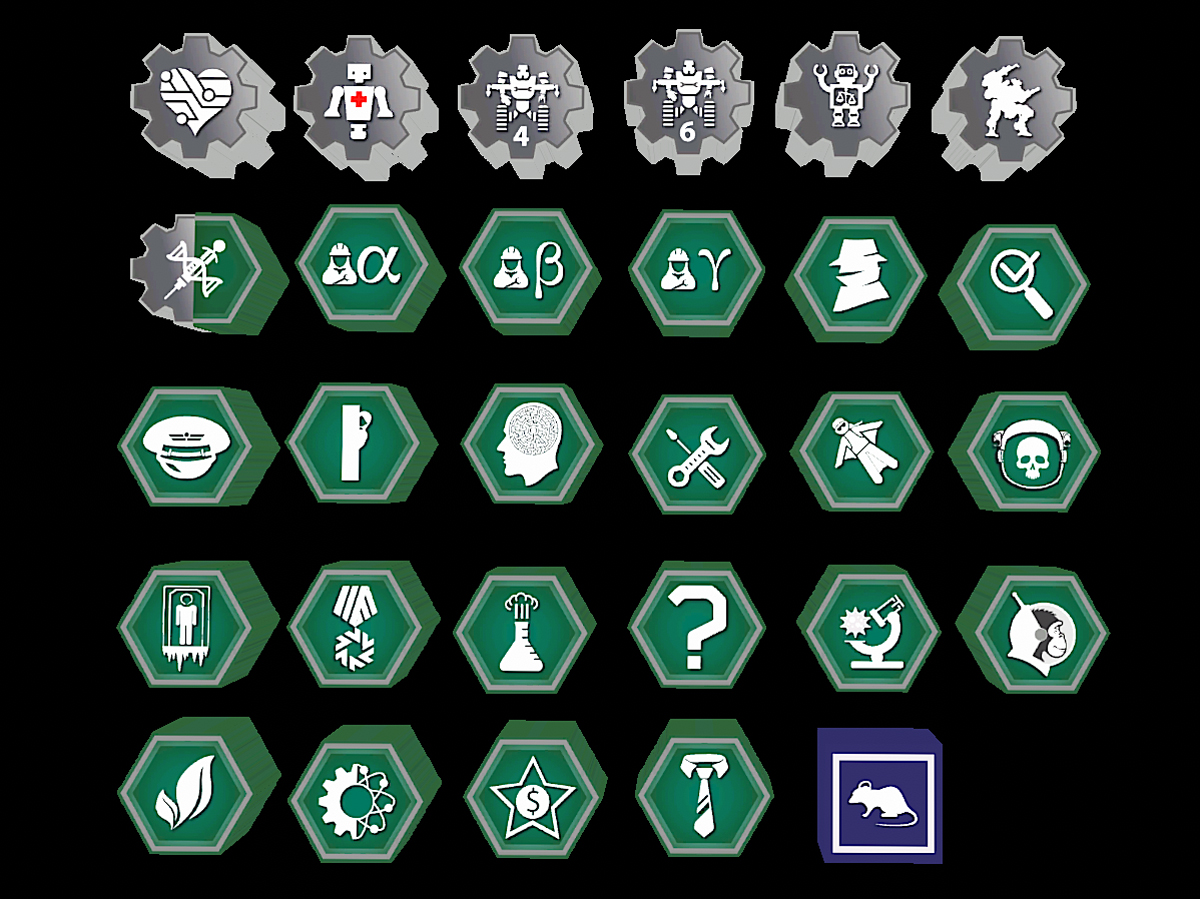
Each character has an icon associated with it, which is usually printed on all of its cards as well as any character-specific tokens. The character pawns are wooden pieces with the icon printed on the top (and the same icon with a red “X” over it on the bottom); grey gears are used for robots and green hexes are used for humans. If you prefer plastic miniatures, you can get those at an additional price, and they’re based on the character artwork. I really like the artwork and the miniatures shown on the Kickstarter page look great, but they may be harder to distinguish until painted.
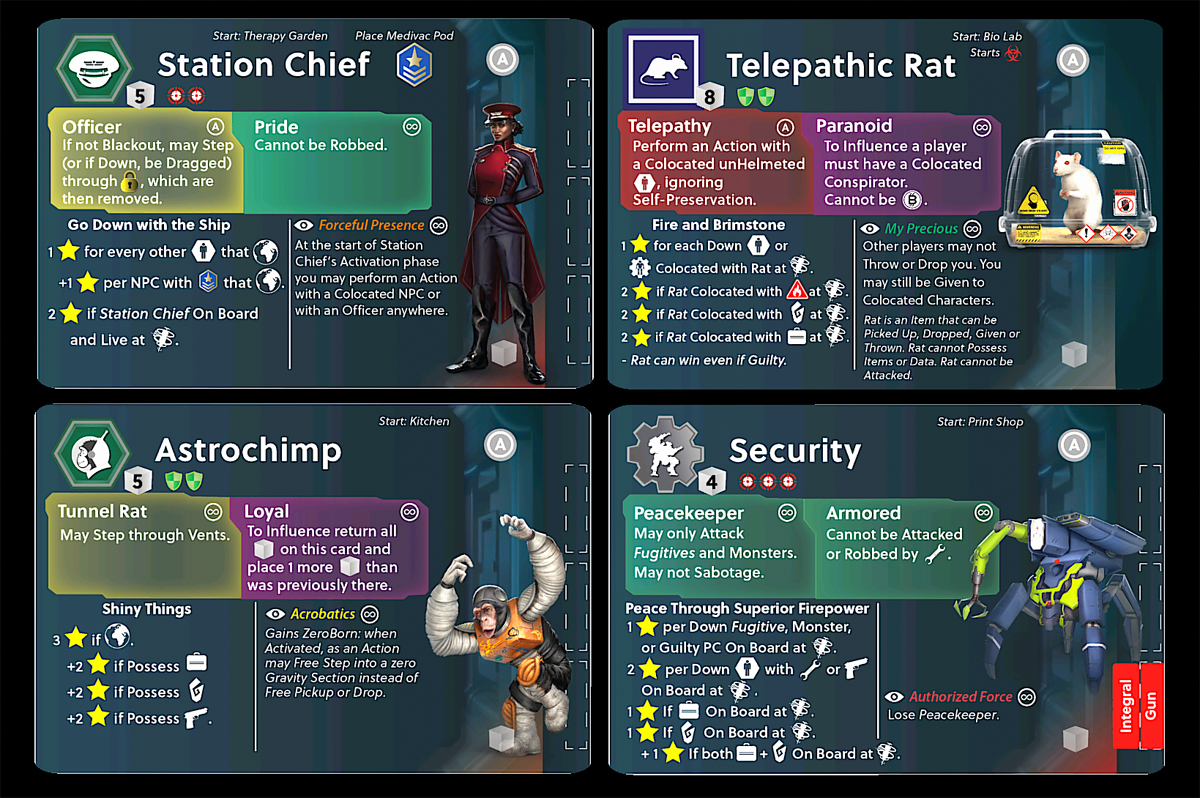
Most of the illustration in the game (as opposed to the icons and diagrams and text) comes on the character cards in the form of the character portraits, and although these are only a small portion of the card, I really like they look. There’s a lot of humor and references to popular sci-fi stories, both in the illustrations themselves and in the names of the character’s goals or abilities. I’ve been told that there’s even more detail in the character bios, though I haven’t read all of those myself yet.
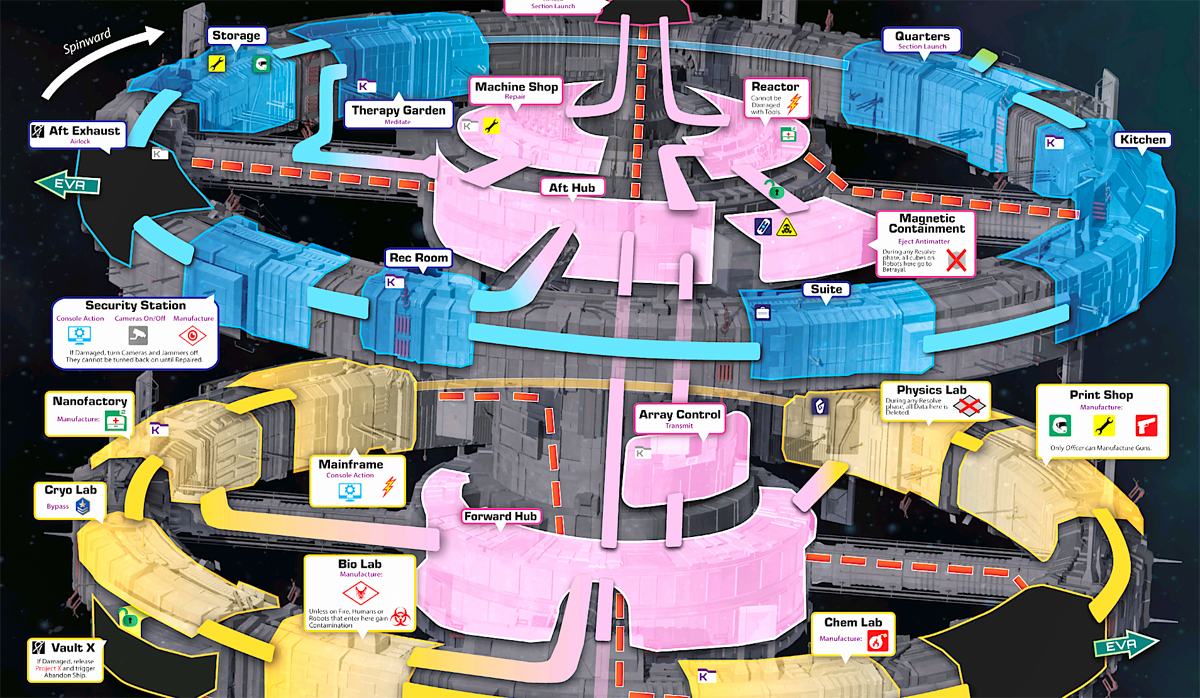
The other big illustration, of course, is the station map itself. There’s a greyed-out illustration of the station—two large rings around a central axis—that has colored sections and paths overlaid on top of it. Each section has a label, along with any actions that can be taken in that room or other effects the room may have. The map looks pretty cool, but it can be a little hard to navigate especially when you’re new to the game. Rooms that look like they’re near each other may in fact be separated by a convoluted route. I think the map looks cool and I’m not sure how to make it easier to interpret visually, but it’s another piece that can feel a bit daunting at first.
For organizing the components, there will be plastic bags provided along with character icon stickers, so that you can sticker each bag to easily sort out the characters and their included components. Maybe not as fancy as a custom plastic tray, but that would be kind of tough to do because there aren’t the same number of components for each character.
How to Play Stationfall
You can download a draft of the rulebook here. Stationfall is also available to try on Tabletop Simulator, or there is a Print and Play option available. The current rulebooks did not include solo rules, but those are in the works.
Since Stationfall is a pretty involved game, I’ll just give a brief outline of how it works without getting into too many fine details.
The Goal
Every character has its own agenda and methods for scoring points—not everyone is interested in getting off the station alive. You score points for completing the agenda of your player character (PC), as well as saving or killing your bonus character (BC) depending on its requirements, and a few other things. The player with the highest score wins.
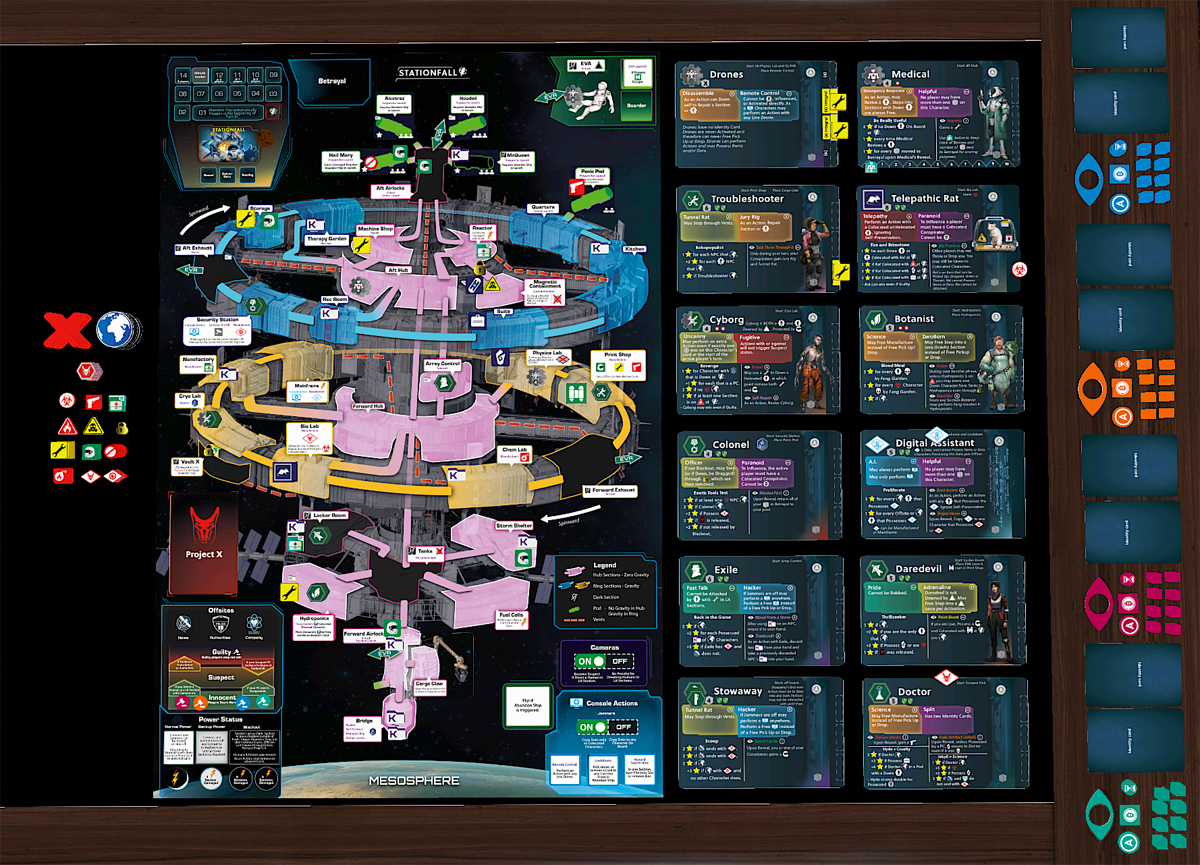
Setup
For each game you’ll use a number of character cards (based on the player count), which are placed next to the board. The board setup includes putting all the characters in their starting locations and following their additional setup instructions, and also seeding the board with tools and helmets where indicated. You’ll also shuffle up all the character kompromat and place those onto the board where indicated. You also put a random Project X card into the vault, face-down.

Shuffle the identity cards for the included characters, and deal 2 to each player. Each player chooses one to be their player character and one to be their bonus character, rotating the card so that it’s upside down and only shows the BC points. All identity cards are kept secret from other players. Each player also takes all the components of their color; the guilt token goes onto the board in the “Innocent” space.
Gameplay
On your turn, you do the following steps in order:
- Reveal (optional) – reveal your PC, which triggers some effects and may give you some abilities.
- Influence (optional) – add any number of influence cubes from your supply to a Live NPC (a character that nobody has revealed themselves as).
- Activate or Renegotiate – place your activation disc on a character where you’re tied for most influence and use that character to take an action; or retrieve your activation disc to your supply and up to 1 influence cube from a character card.
- Resolve – Take care of any end-of-turn effects, indicated by your time markers, or activate the monster if applicable.
There are, of course, some more specific details about these actions, but that’s the general outline. The concept is that if a card has your influence on it, then that character is your “conspirator” and is working with you. When you reveal yourself, you get your own cubes back and everyone else’s cubes on your card go to the “betrayal” section of the board.
Note that you can influence and activate any character that hasn’t been revealed yet, even if it’s not your PC. At the beginning of the game, all of the characters are NPCs, so you can use any of them. Figuring out when to reveal yourself is part of the strategy.
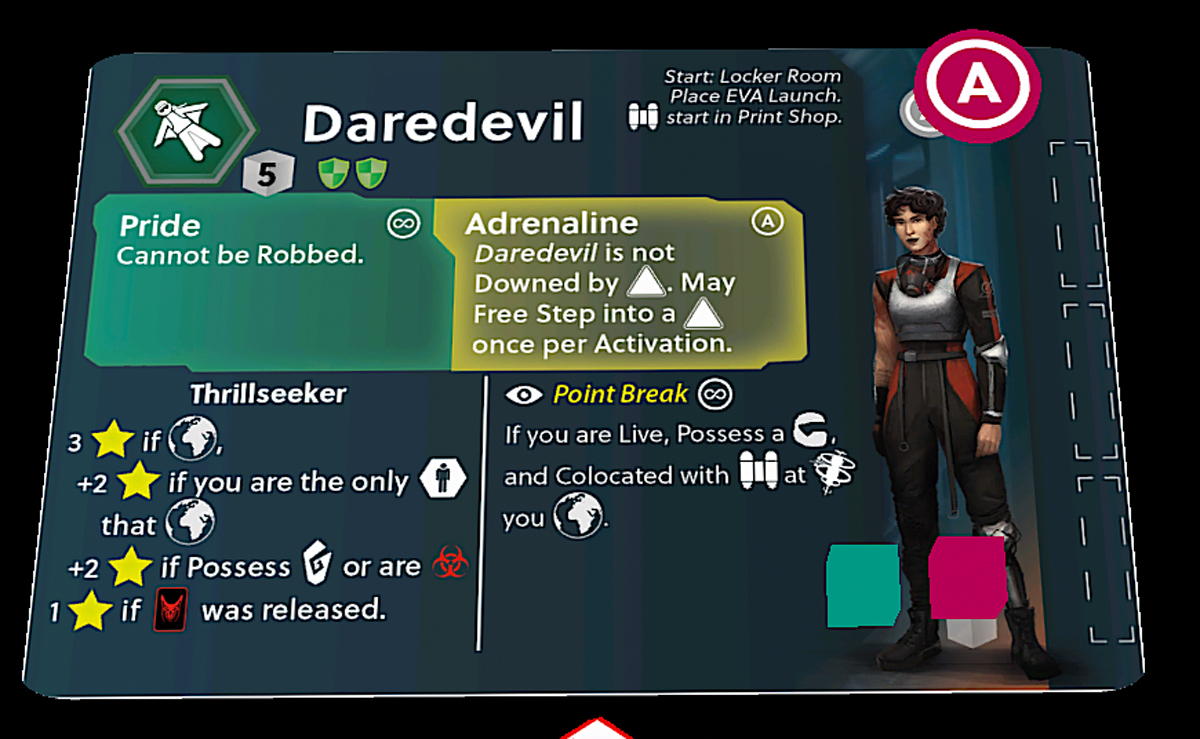
When you activate characters, you typically get a single action, along with a free pick up or drop if there are items in that character’s room. However, you also get one bonus action if there were no activation discs already on that character card, which encourages players to jump around among different characters if they want to take more actions.
There are a host of actions you can take, most of which are pretty intuitive: moving around the station, picking up or dropping (or even throwing) items, and using the specific actions of the room you’re in. You can also attack other characters or sabotage rooms, or hop out into EVA from the airlocks (don’t forget your helmet!). Characters also have their own special abilities that can be used by anyone who activates them, and there are also some special abilities or effects when you’ve revealed yourself as a character.

You can also use kompromat—there’s one per character—to make that character take an action, and you can spend your bribe on any character to do the same. Once characters have been revealed as a PC, you can still attempt to use kompromat or a bribe, but that player may turn it down. Turning down kompromat can affect you on the guilt track, though, so beware!

The time track shows how many “minutes” there are until the station falls into the atmosphere and the game ends, with the time ticking down once per round. However, there are ways that stationfall could occur early, if the antimatter next to the reactor gets armed. (And, yes, there are some characters who just want to see the world burn.)
Game End
The game ends at stationfall, whether because the time marker reaches the end of the track or because the station blew up before then.
First, in turn order, players reveal their PCs if they haven’t already.
Then, in turn order, players whose PCs are carrying data may deliver it to any number of the offsites—the news, the authorities, and the company. Delivering evidence moves all “suspect” players to “guilty,” but there are also other types of data and characters may score for having the right data in the right places.

Finally, you score points.
For your PC, there are various stars listed showing how you score points; the “+” means that you must meet the precondition in order to score those points. For example, the Astrochimp pictured above scores 3 points if they escape to Earth, and additionally scores 2 points each for having the briefcase, the artifact, and a gun. If they have the items but do not escape, they don’t score anything.
For your BC, you score points for green shields if they survived, and red targets if they were down at the end of the game.
You also get 1 point per bribe that you have—whether that’s in your supply or on your PC’s card.
Finally, you lose points if you go over your conspiracy limit, shown on the character card below the name. (Astrochimp has a conspiracy limit of 5.) You lose 1 point per cube that you’ve spent over that limit.
The highest score wins, though guilty players cannot win (unless their character card says otherwise). In case of a tie, the player with fewer cubes in “betrayal” wins, and then the player with more influence cubes left in their supply.

Why You Should Play Stationfall
As I said in my Kickstarter roundup a couple weeks ago, Stationfall is a hilarious, tumultuous game of conspiracies and secret agendas that will leave you with memorable stories each time you play. It’s not a game for everyone, though, so I hope this review will give you a good sense of whether it’ll be a game that your family or gaming group would enjoy.
I typically play games that would be considered light to medium weight; I like games that max out at about an hour or 90 minutes, because I like playing several different titles during a game night. Also, because of my gaming habits as a reviewer, the sad fact is that I don’t always get as deep into any given game, even the ones I really enjoy. Stationfall is a long game that I can tell gets better with experience, as players familiarize themselves with the characters and the station map itself, so that more time can be spent thinking about strategy rather than figuring out the best route out of the kitchen. (I mean, seriously, don’t get stuck in the kitchen.) But despite my usual preferences, I’ve managed to play Stationfall five times in the past month, two of those teaching new players, because it’s been such a blast. It’s a game that I’d want to play a lot, even if I can’t promise that would happen in reality.
Though the game simulates the last 15 minutes (or less) of a failing space station, it can take a couple of hours to play—even longer the first time. The more players you have, the longer the game could take. When teaching the game, it has taken me about an hour to explain the rules while setting up the board—that’s primarily because there is simply so much to read. There are 12 “basic” actions that most characters can do, plus some special character-specific actions, not to mention over a dozen “section” actions depending on which location you’re in. That means either you describe all of the actions a player can take, or you just give a basic outline and let players look up specifics during the game—neither is perfect, but I think the game works well for the type of player who doesn’t mind running around and saying “hmm, what does this button do?” rather than having all of the instructions laid out ahead of time. (And for those who want more details, well, perhaps give them some time to study the rulebook and the board before game night.)
That does mean there can be a bit of downtime between your turns, especially if you had the maximum 9(!) players. However, because of the nature of the game, you’re interested in what other players are doing, and each individual turn is typically fairly short (outside of the time spent agonizing about choices)—one or two actions usually, with sometimes a bribe or a kompromat for some additional actions. Since any player can use any character before they’re revealed, you want to pay attention to what other players are doing. Did somebody move my character in an advantageous direction? Can I figure out what that player is up to? Where did the briefcase get to? Sometimes other players may unintentionally interfere with your plans, but it’s also possible for some serendipitous moments where they get you closer to your goal.
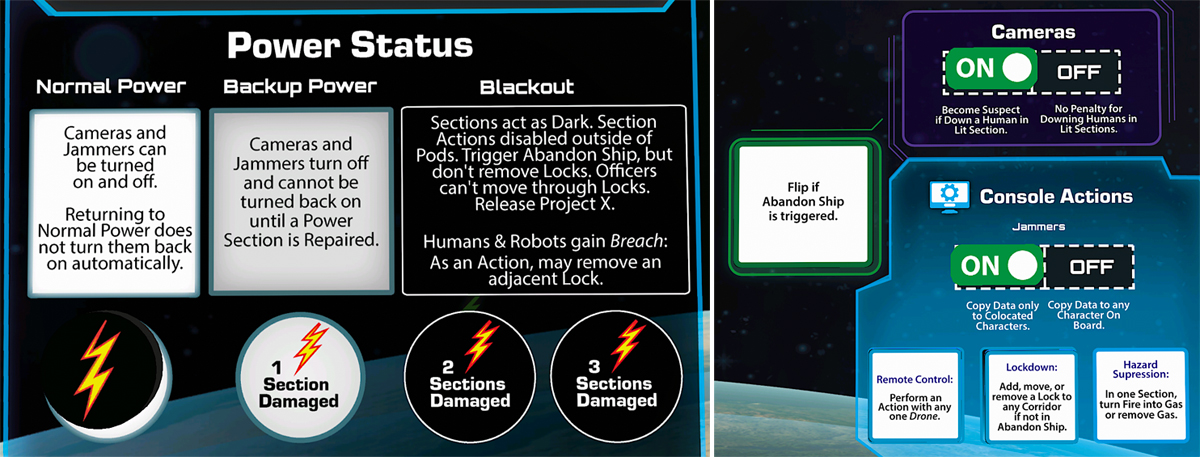
So far, I’ve played with as few as 2 and as many as 6. The 2- and 3-player games are interesting because you get three identity cards each, with one PC and two BCs. That gives you a little more to keep track of and also some more scoring options since there are fewer players to move everyone around. With more players, there’s a lot more chaos, of course, and it’s harder to plan out a strategy too far in advance because the board can change so much between turns, but it can also lead to temporary alliances and a lot of table talk. I’m excited to try a 9-player game eventually, though I think I’d definitely want to do that with experienced players.
Stationfall is a game that has a winner at the end based on points, though I might argue that the scoring isn’t really what makes the game great. I think of the scoring as my character’s motivation—and, in fact, the title of each character’s scoring gives you a hint about their story even without the dossier. The Medical Bot wants to “Be Really Useful” and scores points for reviving humans during the game … which means that it could end up attacking humans so there’s somebody to revive. Ah, unintended consequences of programming. The Cyborg is out for “Revenge” and wants to take down any officers on the station, and set fire to things. The Stowaway, looking for a “Scoop,” wants to get the evidence and information about Project X to the news.
The odd thing, though, is that the characters can have very different scoring caps. If the Stranger fulfills all of their objectives, they score 5 points. But Astrochimp scores 9 points if they get away with all three items. And the Station Chief, who scores points for every other human that makes it off the station, has an even higher scoring potential, especially in larger games when there are more characters in play. I know that Ion Games has been doing a lot of playtesting, recording scores for every character and tweaking the numbers, but it’s not clear on the surface (and, granted, after only 5 plays) whether some characters are simply easier to win with than others.
But, as I said, part of what makes Stationfall fun isn’t just in figuring out how to score points, but in the stories that arise when you play. In one game, we had several characters out in EVA fighting over the jetpack, which allows you to get to earth without a pod. In another, the presence of Legal Bot meant that you needed an NDA in order to launch a pod. I played once as the Inspector, who wants to get evidence out to the authorities, and I spent several turns setting things up to transmit that data … only to have the authorities annihilated by the Project X Death Ray. Sometimes the station is full of death and mayhem, and at other times nearly everyone escapes safely. It just depends on the mix of characters and what everyone decides to do.

Speaking of Project X: that’s one of the secrets of the station. You never know what might be in that vault, though there are ways of finding out. If the power goes out on the ship or if an officer triggers the Bypass, then it reveals Project X and unleashes it. Sometimes it’s a tool, like the Death Ray or the Stable Wormhole. But usually it’s a monster of some sort that will start moving around the station, attacking characters or wrecking sections. Depending on your character, you may be more inclined to open that vault.
And there are lots of other fun things to do on the ship that I haven’t even touched on. Turning off the cameras lets you attack people with impunity. Turning off jammers lets you send data to any character instead of just those in the same room with you. Arming the antimatter will blow things up. Some of the characters have overlays that add new sections or escape pods to the station, such as the Cargo Claw pictured below, which lets you squash people who happen to be outside.
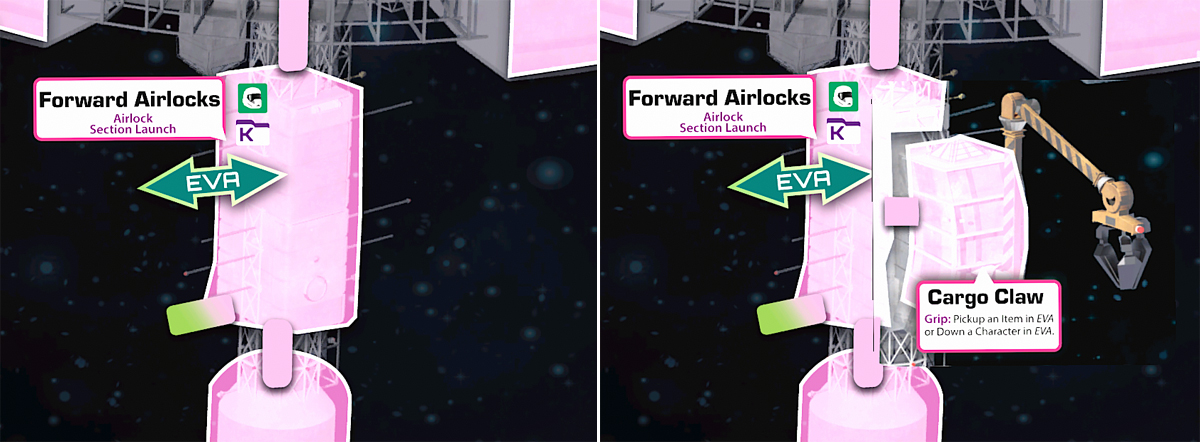
Stationfall will be ideal for a group that plays together regularly and—this is also important—doesn’t mind a lot of direct player conflict. You have to be okay with losing or having your plans go up in smoke, though I’ll note that if that happens there are definitely ways to mess with the other players in the meantime. I played once where the antimatter got ejected and everyone was happy that it would blow up outside the station with no huge consequences … until I brought it in at the last minute and caused an early stationfall, after my own character had safely launched an escape pod. Whoops, did I do that? I’ve also had a player chase down and shoot one of my bonus characters simply because I kept getting in his way.
I’ve seen comparisons made between Stationfall and the popular videogame Among Us, in that there are a bunch of players running around a space station and you might get whacked, and there’s a track that marks you as innocent, guilty, or suspect. However, even with the hidden roles, it’s not quite the same thing: there aren’t a few hidden traitors on a station full of innocents—everyone has their own agenda. The fact that you can move any character around means that it’s not just about watching what the characters are doing, but what the players are doing with them. You don’t win or get any points by figuring out which character somebody is, though you can use that knowledge to make life harder for that player. One thing is true for both, though: you want to play this with friends who don’t mind getting stabbed in the back.
If looking at the map and that list of icons just makes your head spin, or if you prefer games where you can plot out your long-term strategy without a lot of interference from other players, Stationfall may not be a great fit for you. Even though most of the individual rules are pretty simple, there’s just a lot of them to keep track of, so you need a group that can be patient with learning rules, and forgiving when inevitably things get missed the first few times you play.
For me, I didn’t know if Stationfall would be something I’d enjoy at first—the game length in particular put me off—but I’m really glad I took a chance, because I’ve had a lot of fun playing it, even when I don’t win.
For more information or to make a pledge, visit the Stationfall Kickstarter page!
Click here to see all our tabletop game reviews.
![]() To subscribe to GeekDad’s tabletop gaming coverage, please copy this link and add it to your RSS reader.
To subscribe to GeekDad’s tabletop gaming coverage, please copy this link and add it to your RSS reader.
Click through to read all of “Kickstarter Tabletop Alert: Prepare for ‘Stationfall’” at GeekDad.If you value content from GeekDad, please support us via Patreon or use this link to shop at Amazon. Thanks!
